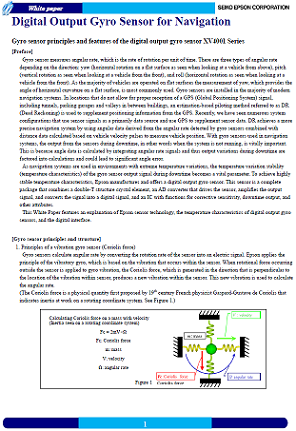
Gyro sensor principles and features of the digital output gyro sensor XV4001 Series
Gyro sensor measures angular rate, which is the rate of rotation per unit of time. There are three types of angular rate depending on the direction: yaw (horizontal rotation on a flat surface as seen when looking at a vehicle from above), pitch (vertical rotation as seen when looking at a vehicle from the front), and roll (horizontal rotation as seen when looking at a vehicle from the front). As the majority of vehicles are operated on flat surfaces the measurement of yaw, which provides the angle of horizontal curvature on a flat surface, is most commonly used. Gyro sensors are installed in the majority of modern navigation systems. In locations that do not allow for proper reception of a GPS (Global Positioning System) signal, including tunnels, parking garages and valleys in between buildings, an estimation-based piloting method referred to as DR (Dead Reckoning) is used to supplement positioning information from the GPS. Recently, we have seen numerous system configurations that use sensor signals as a primarily data source and use GPS to supplement sensor data. DR achieves a more precise navigation system by using angular data derived from the angular rate detected by gyro sensors combined with distance data calculated based on vehicle velocity pulses to measure vehicle position. With gyro sensors used in navigation systems, the output from the sensors during downtime, in other words when the system is not running, is vitally important.
Advertisement
Learn more about Epson Electronics America





